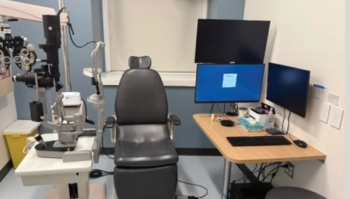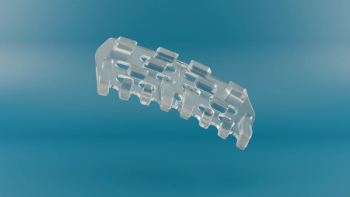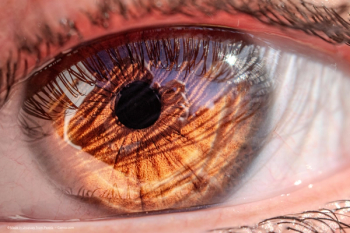
Timolol formulation enhances IOP lowering
Greater, more consistent reductions seen throughout the day compared with brimonidine.
Timolol maleate 0.5%/sorbitol complex (Istalol, ISTA) is a very convenient, effective, and well-tolerated choice for adjunctive therapy in patients on a prostaglandin analogue (PGA) who need further intraocular pressure (IOP) control, according to a clinical trial presented by Jason Bacharach, MD, in a poster at the annual meeting of the American Academy of Ophthalmology.
The investigator-masked study enrolled 40 patients requiring additional IOP lowering after being on a stable regimen of latanoprost 0.005% (Xalatan, Pfizer) for at least 1 month. Patients were randomly assigned 1:1 to receive adjunctive treatment with timolol maleate/sorbitol complex Q.D. in the morning or brimonidine tartrate 0.1% (Alphagan P, Allergan) B.I.D. IOP measurements were obtained at baseline and after 4 weeks at 8 am (peak), 10 am, and 4 pm (trough).
The results showed both treatment groups achieved statistically significant reductions in IOP. However, timolol/sorbitol was associated with a greater and more consistent IOP-lowering effect throughout the day compared with brimonidine, reported Dr Bacharach, associate clinical professor of ophthalmology, California Pacific Medical Center, San Francisco, and medical director, North Bay Eye Associates, Sonoma County, California.
Both timolol/sorbitol and brimonidine were well tolerated. However, medication adherence was poorer in the brimonidine group, where the proportion of patients who admitted missing at least one dose was twice as high as in the timolol/sorbitol group (42% versus 21%).
"In theory," Dr Bacharach said, "timolol is an excellent choice as an adjunct to latanoprost because it provides a complementary mechanism of action for reducing IOP, acting to suppress aqueous humor production, whereas the [PGA] acts primarily by increasing aqueous outflow. In addition, this unique formulation of timolol with sorbitol complex is the only aqueous-based timolol product that is approved by the FDA for once-daily dosing.
"The results of this study confirm that it is highly effective as an adjunct to latanoprost, providing excellent, flat diurnal IOP curves," he continued. "They are consistent with results of a large meta-analysis conducted by van der Valk and colleagues that found timolol provided potent and consistent IOP-lowering at peak and trough and was associated with greater IOP-lowering and less fluctuation compared with brimonidine."
In the prospective study, mean baseline IOP values at the three times ranged between 18.95 mm Hg and 17.1 mm Hg in the timolol/sorbitol group and were consistently lower in the brimonidine group (range, 20.34 mm Hg to 18.6 mm Hg). However, none of the between-group differences was statistically significant.
Tracking IOP
Measurements of IOP at 8 am, 10 am, and 4 pm at day 28 showed mean reductions from baseline ranged from 2.3 mm Hg to 3.6 mm Hg in the timolol/sorbitol group and from 1.0 mm Hg to 2.8 mm Hg in the brimonidine group, although the greater IOP-lowering effect of timolol/sorbitol was not statistically significant.
Mean IOP values at the three measurement times ranged from 15.38 to 14.78 mm Hg in the timolol/sorbitol group and from 18.13 to 17.61 mm Hg among brimonidine users. The differences favoring the timolol/sorbitol group for having a lower mean IOP were statistically significant at both peak (p = 0.044) and trough (p = 0.010).
Patients in the study were asked to complete a questionnaire relating to symptoms that might affect tolerability. Mean scores for redness, itching, stinging/burning, dryness and dry mouth were low in both groups, but there was a trend for brimonidine to be associated with more dry mouth than timolol/sorbitol (p = 0.062).
"Potassium sorbate in the timolol/sorbitol solution may increase burning and stinging on instillation," he said. "In this one-month study, the mean score for burning/stinging was higher in the timolol/sorbitol group. However, the score was not significantly different from the brimonidine group and still low, reflecting that these reactions are generally mild. In addition, they dissipate with continued use."
The addition of the sorbitol complex in the proprietary formulation of timolol maleate enhances lipophilicity of the beta-blocker to increase its penetration through the cornea and into the anterior chamber. This improved ocular bioavailability favors 24-hour IOP control with once-daily dosing, but is not associated with increased systemic levels of timolol. Nevertheless, prescribers need to be aware that some systemic exposure can occur and contraindications to topical beta-blockers must be considered.
"I always check the patient's pulse to rule out bradycardia, review the history for other cardiac disease or airway disease that would preclude use of a nonselective beta-blocker, and send a letter to inform the primary care physician when I am initiating beta-blocker treatment," Dr Bacharach concluded. "In the absence of any of these findings, the timolol/sorbitol product is a great choice whenever beta-blocker treatment is indicated."
Newsletter
Get the essential updates shaping the future of pharma manufacturing and compliance—subscribe today to Pharmaceutical Technology and never miss a breakthrough.













































